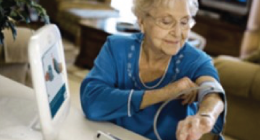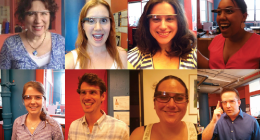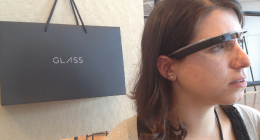Tablet Takeover: The Delta Terminal Transformation
June 1, 2015
by Cecilia Brown, Research Consultant
 Source (from left to right): icrave.com, icrave.com (bottom center), Cecilia Brown (top center), telegraph.co.uk
Source (from left to right): icrave.com, icrave.com (bottom center), Cecilia Brown (top center), telegraph.co.uk
The future has arrived. That is, the future has arrived in the Delta Terminal at New York’s JFK airport. I was there a week ago and was shocked to find a tablet mounted to every seat in the Delta terminal, both in gate waiting areas and at restaurant tables. Thanks to ICRAVE, an innovation studio tasked with reinventing the Delta concourse dining experience, airport-goers will be free of the anxieties that often accompany a 2-hour gate-wait with a dead phone and no open outlets. There is certainly an appeal here. Food can be ordered directly from an iPad without having to make eye contact or exchange words with a real person. The news can be read without lugging around the New York Times. It’s easy to find out the latest on Queen B and Jay-Z without having to shell out your lunch money on People magazine.
There is no question that the conveniences that characterize the digital age are abounding, and having limitless access to WiFi (in a place where solid internet access is historically hard to come by) is inarguably a step up. People walk in here and look like they’re watching money fall from the sky. There’s an inevitable excitement that surrounds technology (particularly when it’s free!) However, while lost in the excitement of these seductive new devices, the potential downsides that emerge with the transformation of a public space into a conglomeration of screens are overlooked.
 Source: icrave.com (left side), slideshare.net (center), blogcdn.com (right side)
Source: icrave.com (left side), slideshare.net (center), blogcdn.com (right side)Sherry Turkle, a professor of Science, Technology, and Society at MIT, coined the term to describe the moments when we are with one another, yet simultaneously connected elsewhere via technology. As I sat down to breakfast in the terminal, I found myself in an “alone together” designed space. Couples were eating breakfast with eyes transfixed on the tablets in front of them rather than on their partner across the table. Entire families ate their food in silence. Groups of friends sat at tables entirely unaware of each other’s presence as they scrolled through images from last week’s Met Gala red carpet show and checked their Facebook notifications. Time and again I watched the tablet obstruct meaningful human interaction and remove people from their environment, creating a space that induced a mentality of “being there while not being there.”
This is certainly not the first time digital technology has found its way into the public space as the integration of tablets, touch screens, and tap-and-pay apps have rapidly advanced in the last few years. Many of these technologies have made our lives vastly more efficient (e.g. subway touchscreens, the Starbucks app.) We need to be careful not to assume that plopping hundreds of tablets into a public space will innately enhance the quality of the experience for those in that space.
 Source: mobilecastmedia.com (left side), imore.com (center), gizmag.com (right side)
Source: mobilecastmedia.com (left side), imore.com (center), gizmag.com (right side)
Take my dad, for example. He’s a simultaneous tech junky and tech skeptic. Before sitting down to breakfast he searched the terminal tirelessly for a tablet-free table. There wasn’t a single table or chair in the terminal without one. To him, this felt like the choice to engage had been taken away from him. Sure, a person could sit there and choose to talk to their friend over using the tablet to play, but most in the terminal were not making that decision-- largely because technology tempts and lures us in a way that face-to-face conversation struggles to compete. The result is that the new Delta Terminal looks more like a cyborg den than an airport terminal.
 Source: frenchliving.co.uk
Source: frenchliving.co.ukThe question here is, how can we make these experiences feel seamless rather than disjointed, communal rather than isolating, and most importantly, how can we design for a balance between our interactions with technology and each other?
What are some situations in your life where you’ve witnessed digital become integrated into a non-digital environment in an adverse way? Share your thoughts in the comments section below.
Designs By Lisa Vissichelli, Digital Designer and Adel Brihmat, Digital Design Assistant
Edited By Gina Gioldassis, Executive Assistant to the CEO
Social Media by Janine Walsh, Operations & Community Manager














